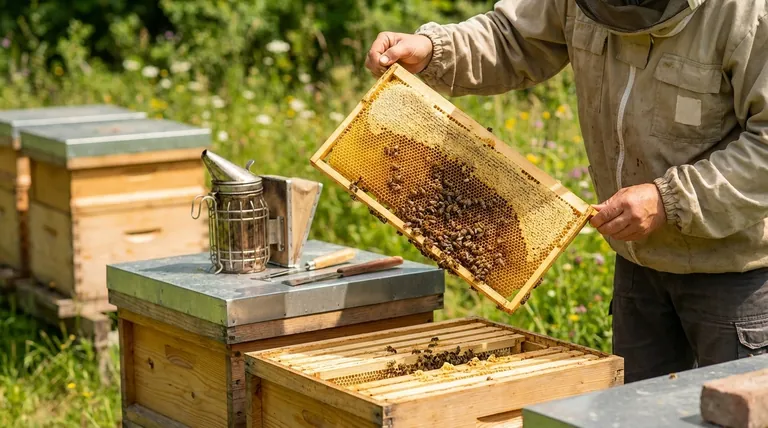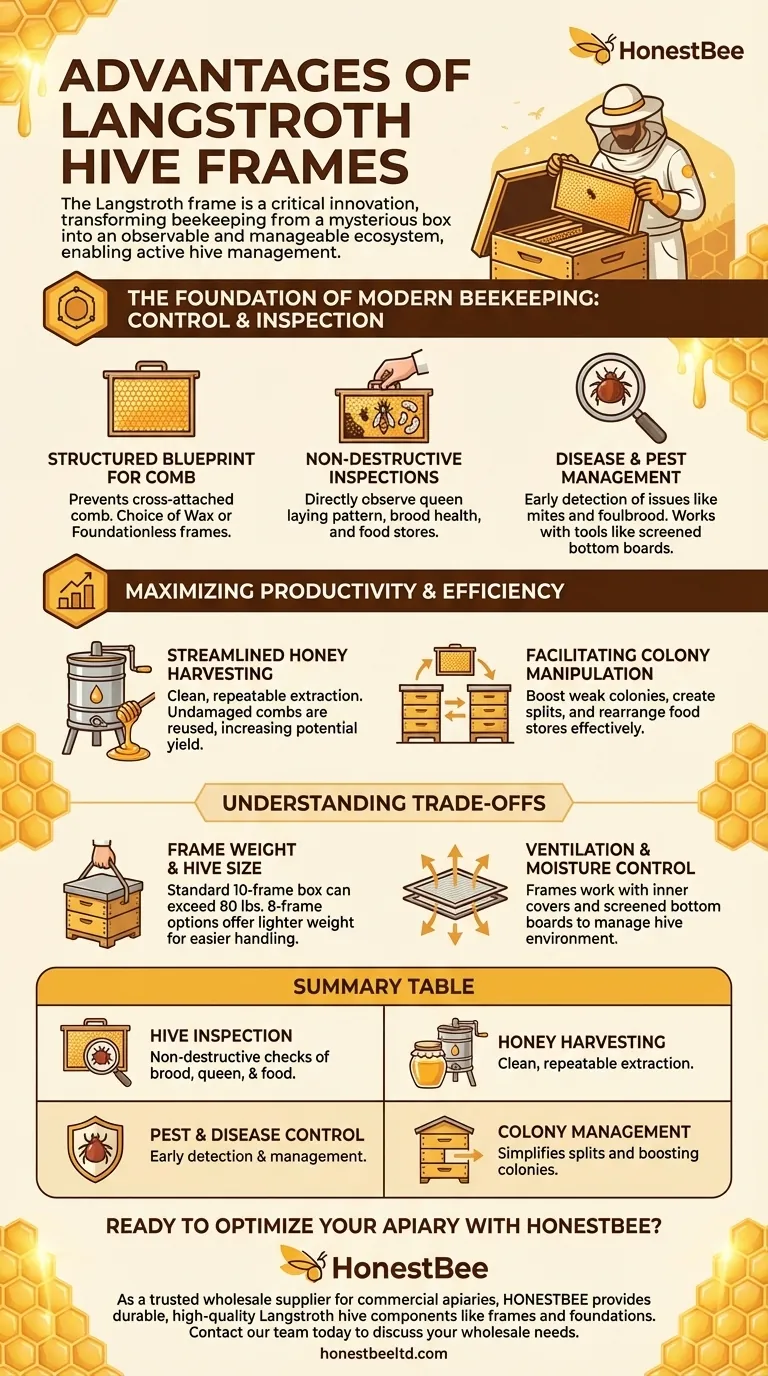In short, the frames in a Langstroth hive are its most critical innovation, providing a structured and removable system for comb building. This design transforms beekeeping by giving the beekeeper unprecedented control to inspect hive health, manage the colony, and harvest honey without destroying the hive.
The central advantage of frames is not just about holding honey; it's about enabling active hive management. They turn the beehive from a closed, mysterious box into an observable and manageable ecosystem, which is the foundation of all modern beekeeping practices.

The Foundation of Modern Beekeeping: Control and Inspection
The primary benefit of the Langstroth frame system is that it makes the inner workings of the hive accessible. This accessibility is the key to proactive beekeeping.
Providing a Structured Blueprint for Comb
Frames provide a neat, orderly structure for bees to build their comb. This prevents the chaotic, cross-attached comb common in more primitive hive types.
This predictable structure is what allows each frame to be removed individually. The beekeeper can choose to use frames with a wax foundation for uniform cell size or foundationless frames to encourage more natural comb construction.
Enabling Non-Destructive Hive Inspections
Because each frame can be lifted out, a beekeeper can perform detailed inspections without tearing the hive apart.
You can directly observe the queen's laying pattern, check the health of the brood, and assess the colony's food stores (honey and pollen). This is impossible in hives without movable frames.
Simplifying Disease and Pest Management
Regular inspections enabled by frames are your first line of defense against pests and diseases. You can spot problems like Varroa mites, chalkbrood, or foulbrood early.
While a tool like a screened bottom board can help passively reduce Varroa mite populations by allowing them to fall out of the hive, it is the frame inspection that allows you to confirm the level of infestation and determine if more active treatments are necessary.
Maximizing Productivity and Efficiency
Beyond health, frames are designed to make the beekeeper's work more efficient and productive, directly impacting the success and yield of the apiary.
Streamlining Honey Harvesting
Frames make honey extraction a clean and repeatable process. The beekeeper can select frames that are full of capped honey, remove them from the hive, and extract the honey using a centrifuge.
The empty, undamaged combs can then be returned to the hive, saving the bees an enormous amount of energy they would otherwise spend rebuilding wax. This dramatically increases the potential honey yield.
Facilitating Colony Manipulation
Frames give you the power to manage your colony's strength and population. You can move frames of brood from a strong hive to a weaker one to boost its population.
You can also use frames to create new colonies (splits) or to rearrange food stores within the hive to ensure the bees have what they need, where they need it.
Understanding the Trade-offs
While the frame system is revolutionary, it involves choices that come with specific trade-offs.
Frame Weight and Hive Size
The standard Langstroth hive body holds 10 frames. A deep hive body full of 10 frames of honey can be extremely heavy, often exceeding 80 pounds.
To address this, many beekeepers opt for 8-frame equipment. While this reduces the overall yield per box, the lighter weight makes lifting and inspections far more manageable, especially for those with physical limitations.
Ventilation and Moisture Control
The hive body is a system that works together. While frames provide the internal structure, components like the inner cover and bottom board manage the environment.
An inner cover provides insulation and a crucial air gap, preventing condensation from dripping down onto the bees. A screened bottom board improves summer ventilation and helps control moisture in winter, both of which are critical for the health of the colony living on the frames.
Making the Right Choice for Your Goal
Your beekeeping goals will determine how you leverage the frame system.
- If your primary focus is maximizing honey production: Choose 10-frame equipment and use frames with foundation to encourage fast, uniform comb for efficient extraction.
- If your primary focus is ease of management and lifting: Opt for 8-frame equipment to reduce the weight of hive bodies and supers.
- If your primary focus is a more natural approach: Use foundationless frames to allow bees to build their own comb size and configuration, but be prepared for less uniform results.
- If your primary focus is colony health and overwintering success: Combine frame inspections with tools like screened bottom boards and proper inner covers to actively manage pests and moisture.
Ultimately, the movable frame is the component that empowers you to be a proactive and effective beekeeper.
Summary Table:
| Advantage | Key Benefit |
|---|---|
| Hive Inspection | Enables non-destructive checks of brood, queen, and food stores. |
| Honey Harvesting | Allows for clean, repeatable extraction with a honey extractor. |
| Pest & Disease Control | Facilitates early detection and management of issues like Varroa mites. |
| Colony Management | Simplifies tasks like making splits and boosting weak colonies. |
Ready to optimize your apiary with the right equipment?
As a trusted wholesale supplier for commercial apiaries and beekeeping equipment distributors, HONESTBEE provides the durable, high-quality Langstroth hive components you need to succeed. From robust frames and foundations to essential tools like screened bottom boards, we support your operations with reliable gear built for scale and efficiency.
Contact our team today to discuss your wholesale needs and discover how our supplies can help you build a more productive and manageable beekeeping business.
Visual Guide

Related Products
- Professional In-Hive Bee Feeder HONESTBEE Frame for Beekeeping
- Stainless Steel 9 Frame Hive Spacer Durable Precise for Commercial Beekeeping
- Professional Bee Frame Wiring Tool with Integrated Tensioning System by HONESTBEE
- Long Langstroth Style Horizontal Top Bar Hive for Wholesale
- Assembled Wooden Bee Frames with Beeswax Foundation Ready to Use by HONESTBEE
People Also Ask
- What are the two most popular types of honey bee feeders? A Guide to Frame and Bucket Feeders
- What is a frame in a Langstroth style beehive? The Key to Modern, Manageable Beekeeping
- What is a frame feeder and how does it work? An Efficient In-Hive Feeding Solution
- What are the standard dimensions for Langstroth beehive frames? Choose the Right Size for Your Apiary
- Where should a bee feeder be placed? The Essential Guide to Hive Safety & Efficiency



















